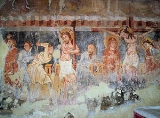
Ghelinta
Encyclopedia
Ghelinţa is a commune in Covasna County
, Romania
. It is composed of two villages, Ghelinţa and Harale (Haraly).
It formed part of the Székely Land
, ethno-cultural region of the historical Transylvania
province.
Hungarian majority. According to the 2002 Census
it has a population of 4,774 of which 98.49% or 4,702 are Székely
Hungarian.
Catholic Church with its murals from the 13th century is the main tourist attraction of the village.
Covasna County
Covasna is a county of Romania, in Transylvania, with the capital city at Sfântu Gheorghe.-Demographics:In 2002, it had a population of 222,449 and the population density was 60/km².*Hungarians – 73.79% *Romanians – 23.28%...
, Romania
Romania
Romania is a country located at the crossroads of Central and Southeastern Europe, on the Lower Danube, within and outside the Carpathian arch, bordering on the Black Sea...
. It is composed of two villages, Ghelinţa and Harale (Haraly).
It formed part of the Székely Land
Székely Land
The Székely Land or Szekler Land refers to the territories inhabited mainly by the Székely, a Hungarian-speaking ethnic group from eastern Transylvania...
, ethno-cultural region of the historical Transylvania
Transylvania
Transylvania is a historical region in the central part of Romania. Bounded on the east and south by the Carpathian mountain range, historical Transylvania extended in the west to the Apuseni Mountains; however, the term sometimes encompasses not only Transylvania proper, but also the historical...
province.
Demographics
The commune has an absolute SzékelySzékely
The Székelys or Székely , sometimes also referred to as Szeklers , are a subgroup of the Hungarian people living mostly in the Székely Land, an ethno-cultural region in eastern Transylvania, Romania...
Hungarian majority. According to the 2002 Census
Census
A census is the procedure of systematically acquiring and recording information about the members of a given population. It is a regularly occurring and official count of a particular population. The term is used mostly in connection with national population and housing censuses; other common...
it has a population of 4,774 of which 98.49% or 4,702 are Székely
Székely
The Székelys or Székely , sometimes also referred to as Szeklers , are a subgroup of the Hungarian people living mostly in the Székely Land, an ethno-cultural region in eastern Transylvania, Romania...
Hungarian.
Tourist attraction
The St. EmericSaint Emeric of Hungary
Prince St. Imre, also Henricus, Emeric, Emerick, Emmerich, Emericus or Americus was the son of King St. Stephen I of Hungary and Giselle of Bavaria. He is assumed to be the second son of Stephen, he was named after his uncle, St...
Catholic Church with its murals from the 13th century is the main tourist attraction of the village.

